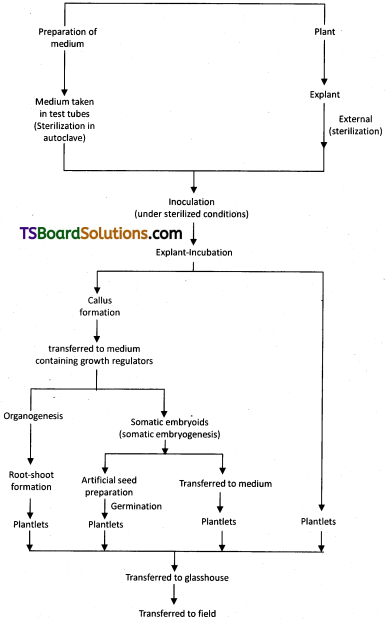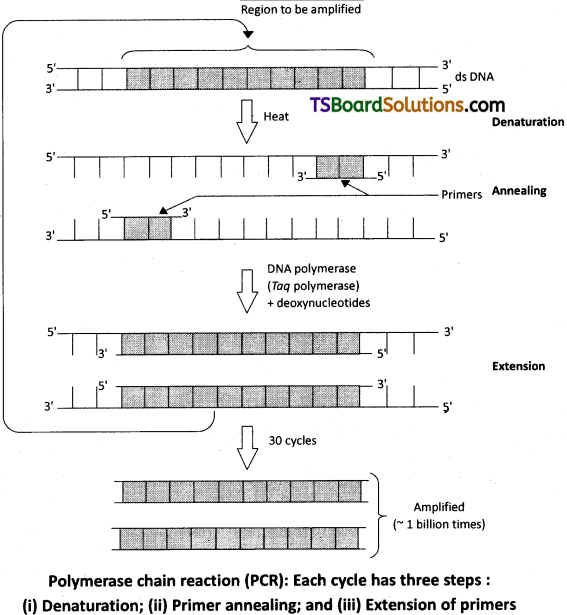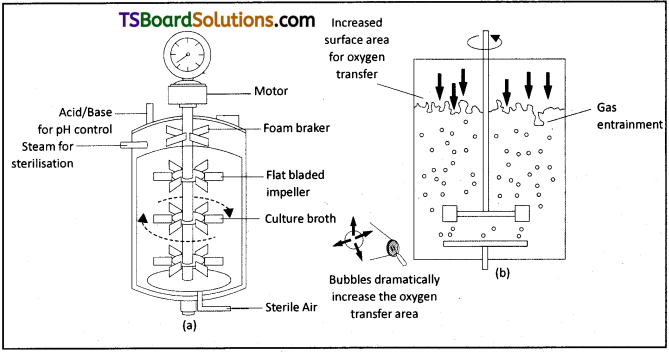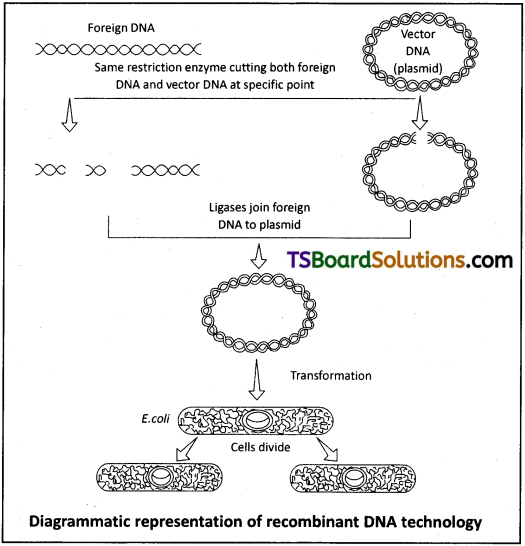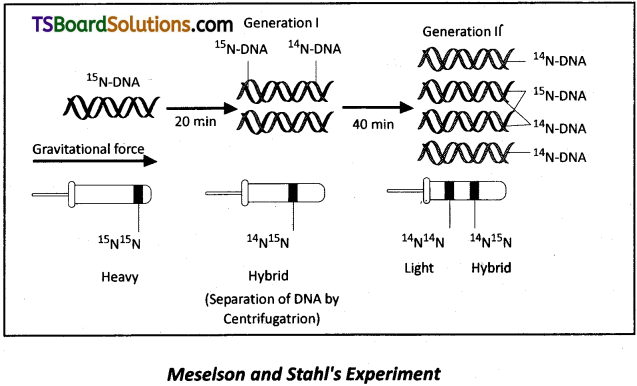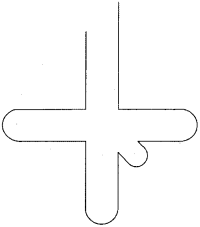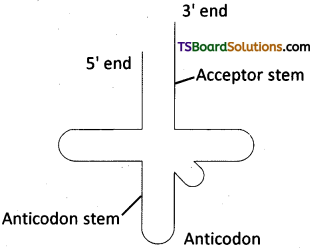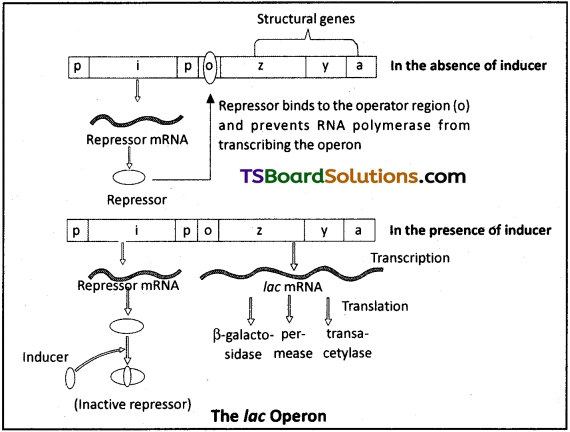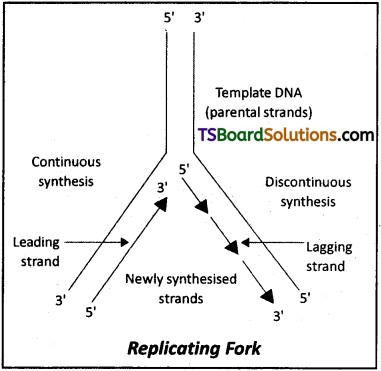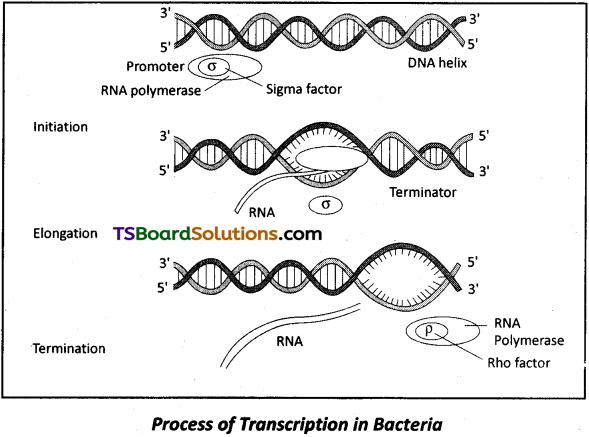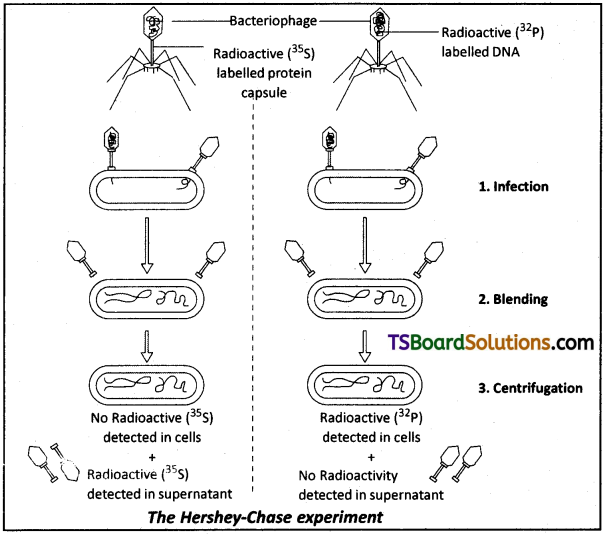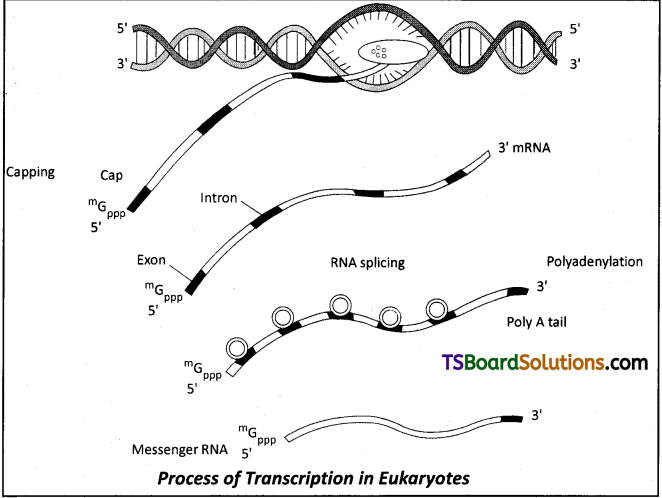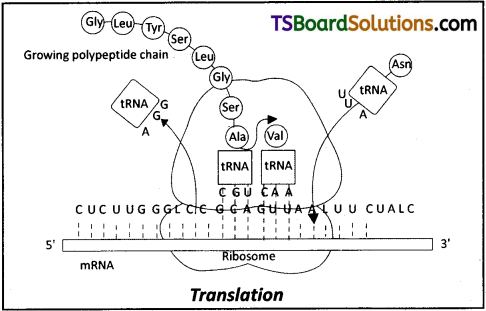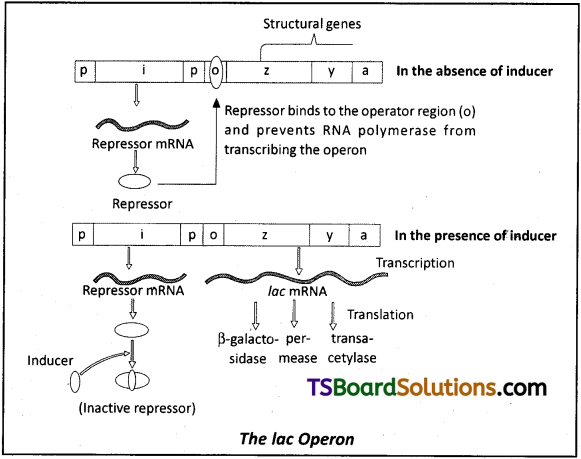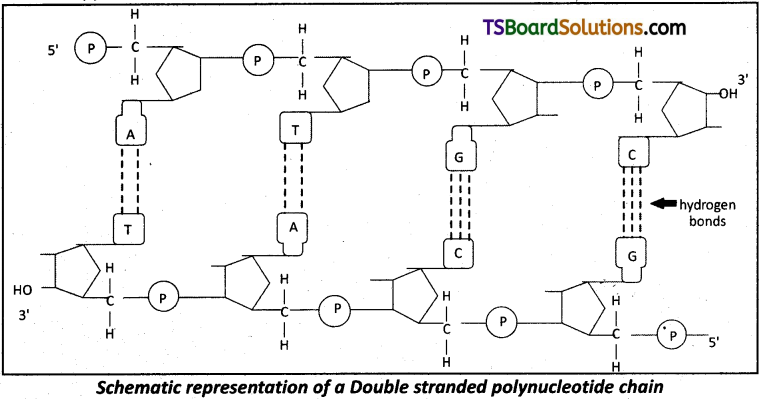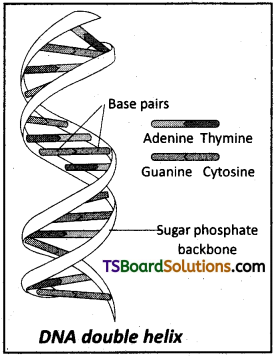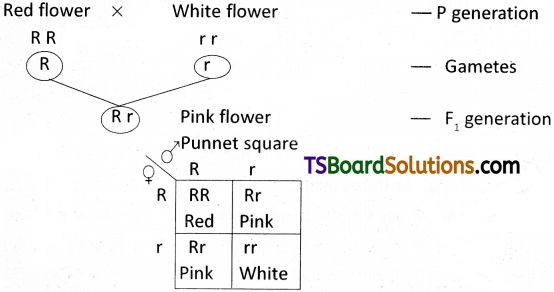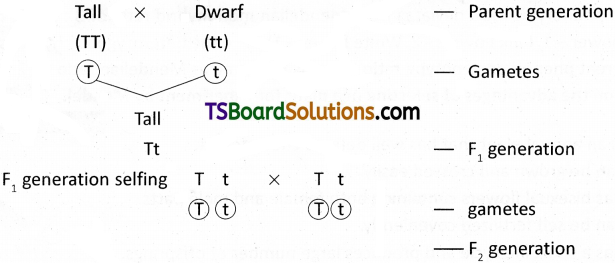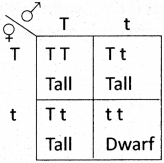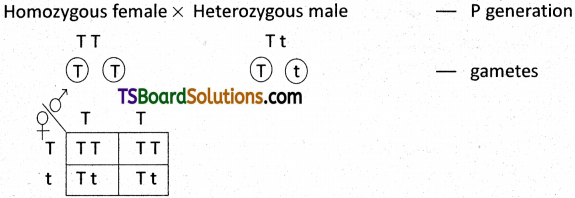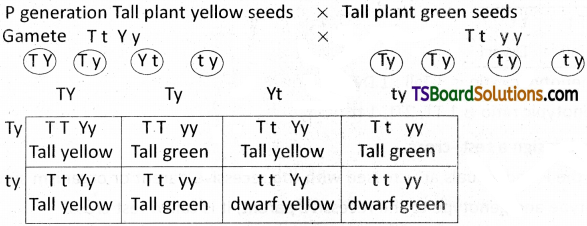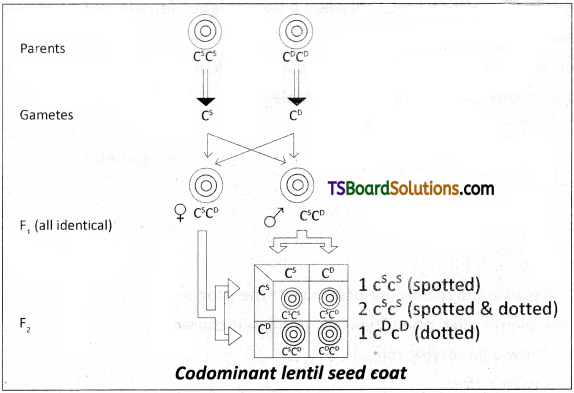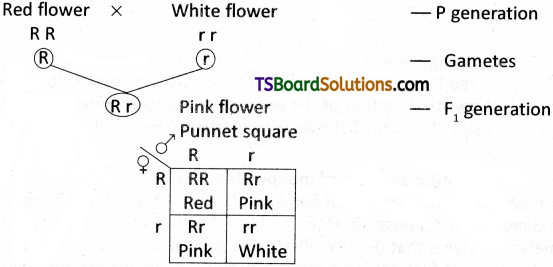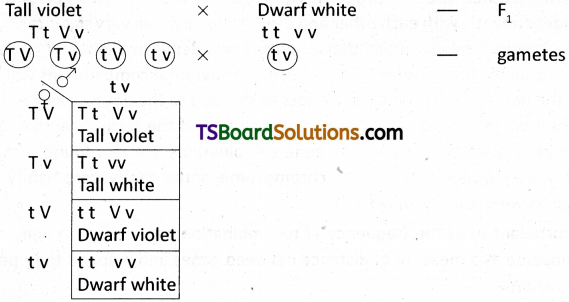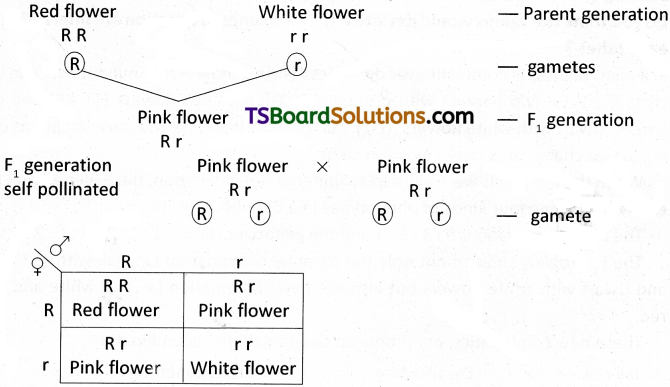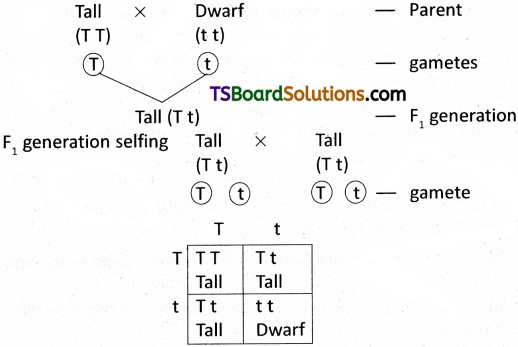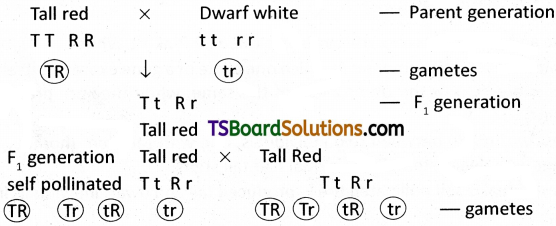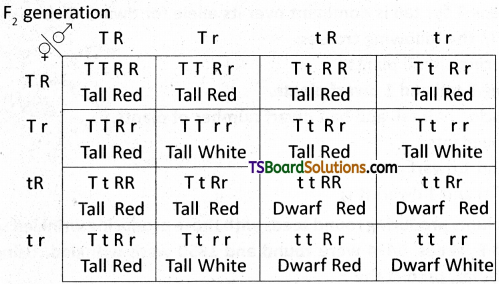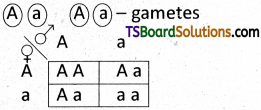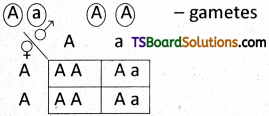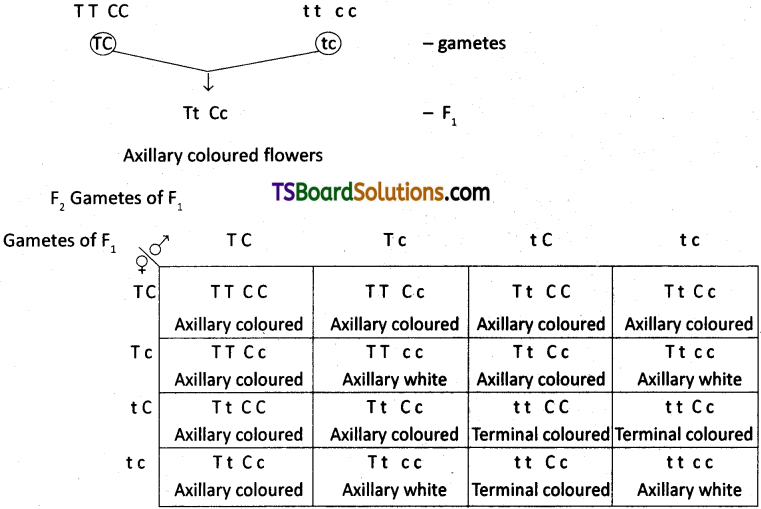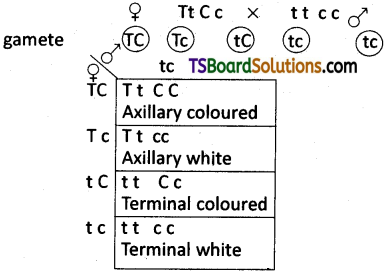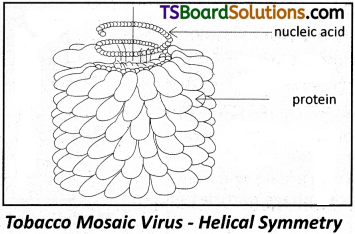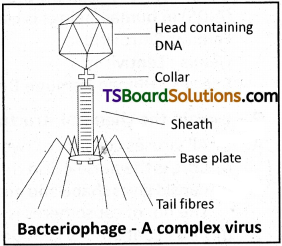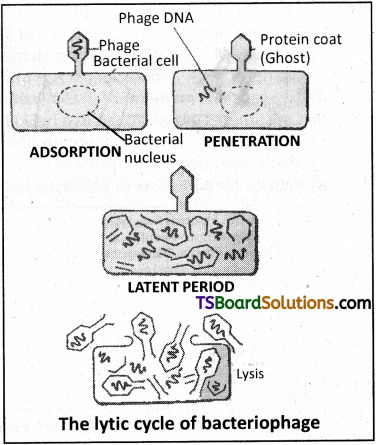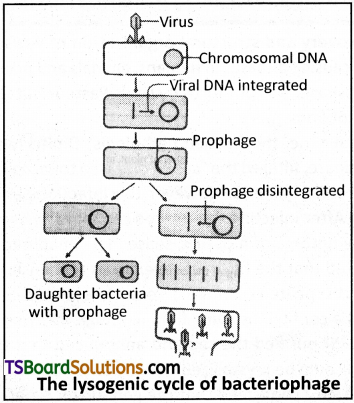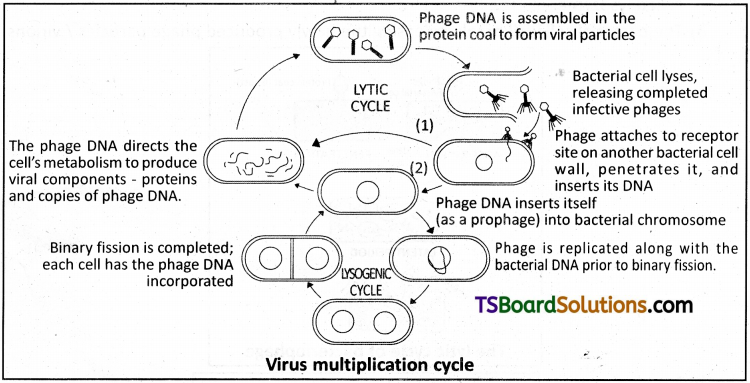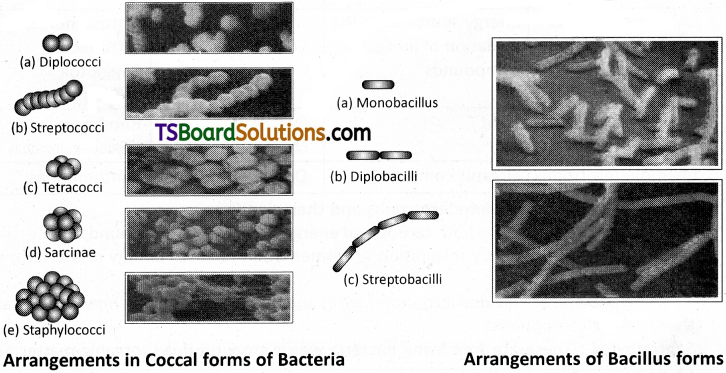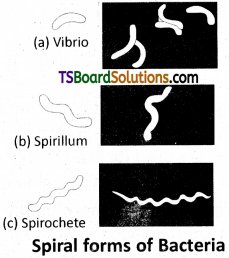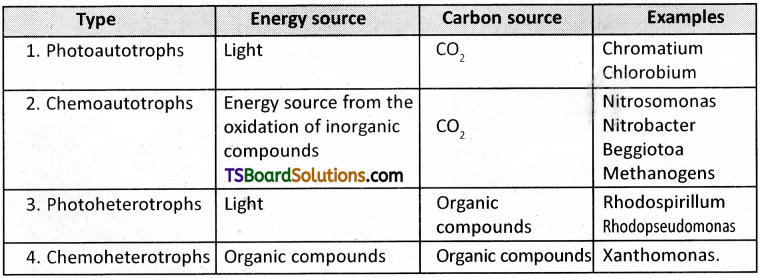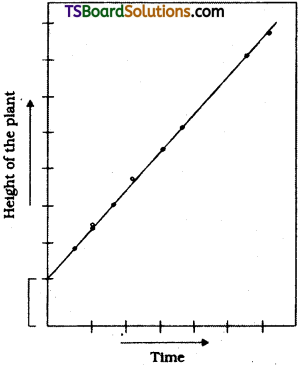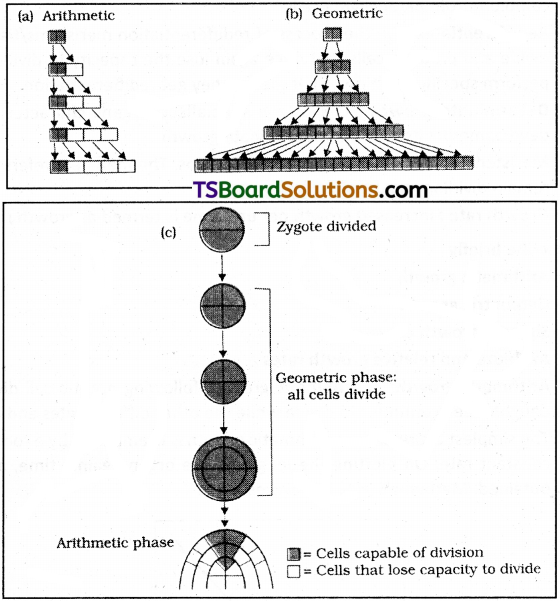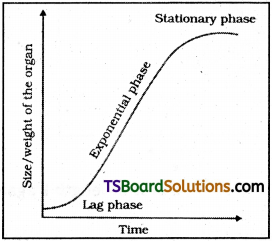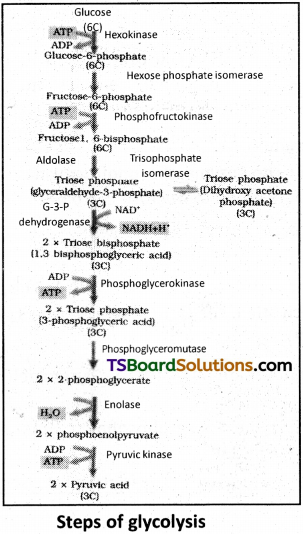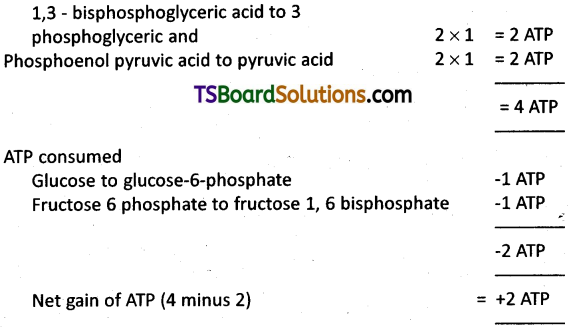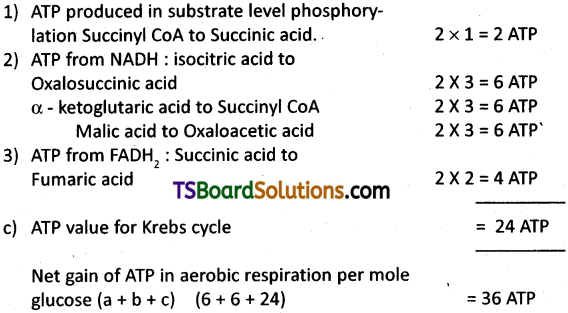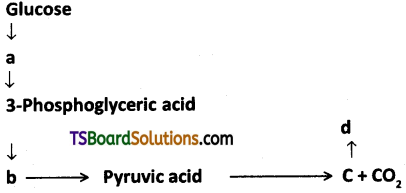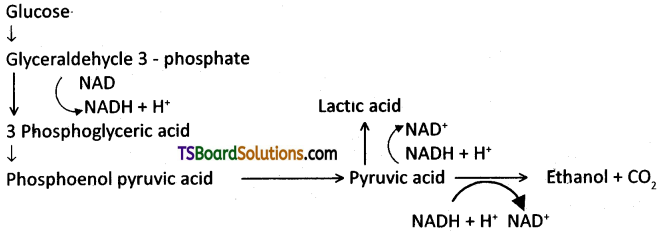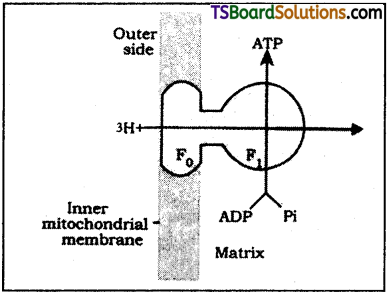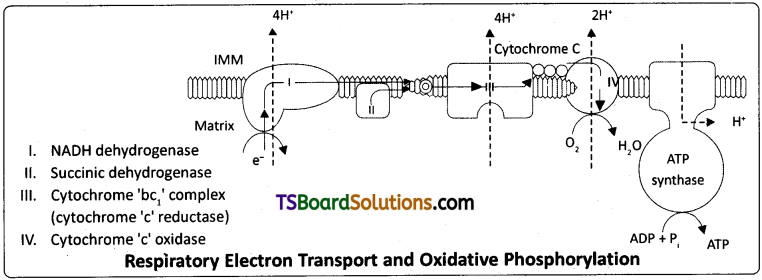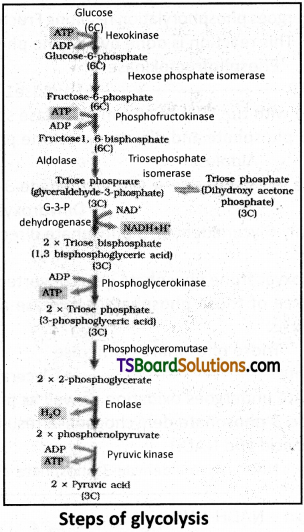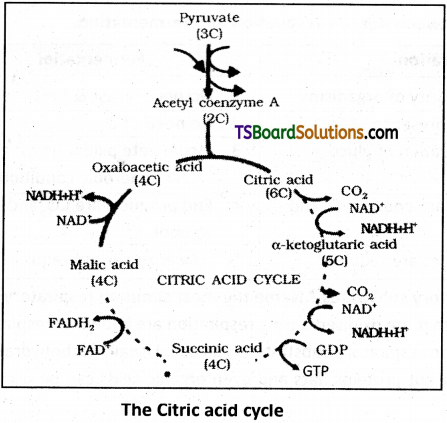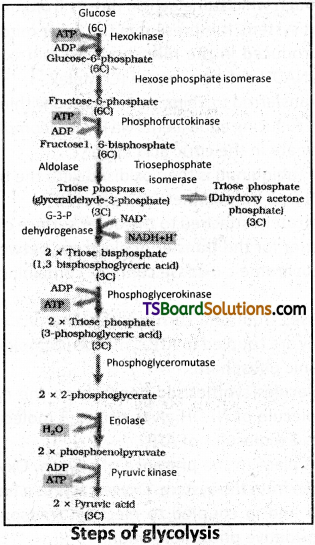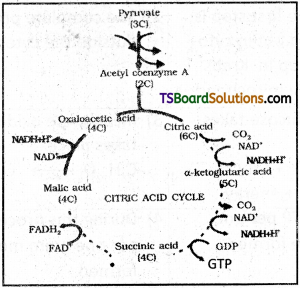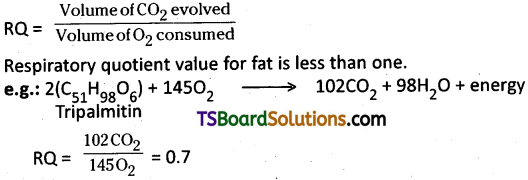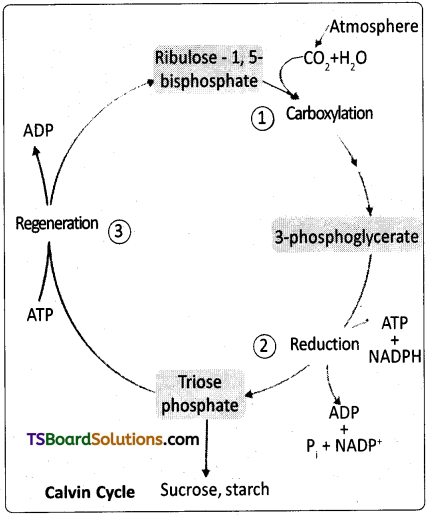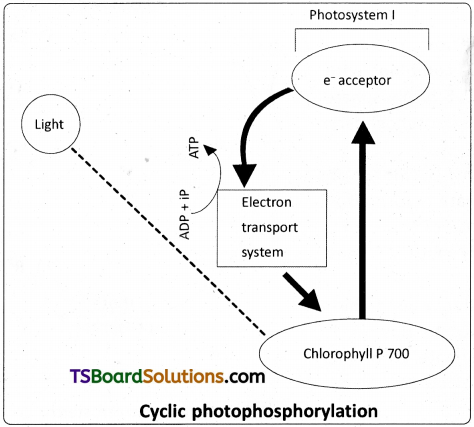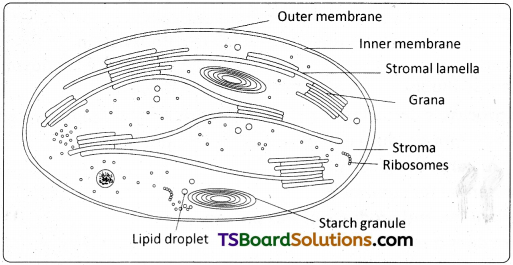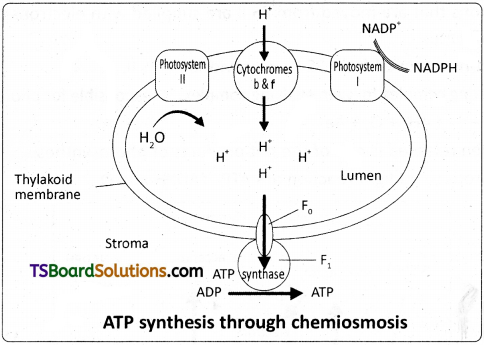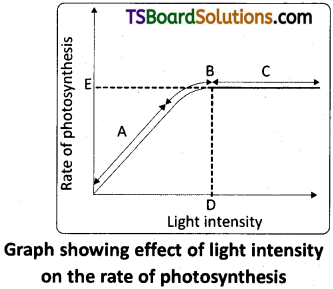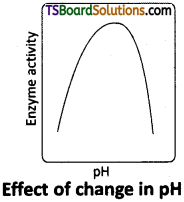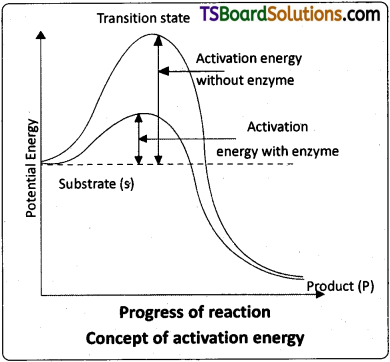Telangana TSBIE TS Inter 2nd Year Botany Study Material 14th Lesson Microbes in Human Welfare Textbook Questions and Answers.
TS Inter 2nd Year Botany Study Material 14th Lesson Microbes in Human Welfare
Very Short Answer Type Questions
Question 1.
Why does ‘Swiss cheese’ have big holes? Name the bacteria responsible for it. [Mar. 2020, 18; May 14]
Answer:
- Large holes in ‘Swiss cheese’ are due to the production of a large amount of CO2 by a Bacterium.
- Propionibacterium sharmanii is responsible for it.
Question 2.
What are fermentors? [May 17; Mar. 14]
Answer:
- Very large vessels that are used to grow microbes for production of valuable products on an industrial scale.
- Beverages like wine, beer, whisky, brandy and rum are produced through fermentation of malted careals and fruit juices by yeast.
Question 3.
Name a microbe used for statin production. How do statins lower blood cholesterol level?
Answer:
- Statins are produced by the yeast, Monascus purpureus.
- The act by competitively inhibiting the enzyme responsible for the synthesis of cholesterol.
Question 4.
Why do we prefer to call secondary waste water treatment as biological treatment?
Answer:
- During secondary waste water treatment, the aeration allows vigorous growth of useful aerobic microbes into floes and reduces BOD (Biochemical Oxygen Demand) of the effluent.
- The microbes consume the major part of the organic matter in the effluent and hence secondary waste water treatment is called Biological treatment.
Question 5.
What is Nucleopolyhedrovirus is being used for nowadays?
Answer:
- Nucleopolyhedrovirus are Baculoviruses, used as biocontrol agents.
- They attack insect and other arthropods. They are species-specific,’narrow spectrum insecticides and have no negative impact on plants, birds, mammals, fish and even non-target insects.
![]()
Question 6.
How has the discovery of antibiotics helped mankind in the field of medicine?
Answer:
- Penicillin was extensively used to treat American soldiers wounded in World War – II.
- Antibiotics have greatly improved our capacity to treat dreadly diseases like plague, diphtheria, whooping cough and leprosy.
Question 7.
Why is distillation required for producing certain alcoholic drinks?
Answer:
- Strong alcoholic drinks such as whisky, brandy and rum with a higher concentration of ethanol are produced by the distillation of the fermented broth.
- Because, yeasts poison themselves to death when the concentration of alcohol reaches about 13 percent.
Question 8.
Write the most important characteristic that Aspergillus niger, Clostridium butylicum and Lactobacillus share.
Answer:
- These are organic acid producers.
- Aspergillus niger (a fungus) produce citric acid, Clostridium butylicum (a bacterium) produce butyric, and acid Lactobacillus share (a bacterium) produce lactic acid.
Question 9.
Give any two microbes that are useful in biotechnology. [March 2014]
Answer:
- Streptiococcus to produce stroptokinase, a clot buster for removing clots from the blood vessels of patients with myocardial infection.
- Trichoderma Polysporum to produce cyclosporin – A, an immuno oppressive agent in organ transplant patients.
Question 10.
Name any two genetically modified crops.
Answer:
- Bt-cotton
- Bt-brinjal.
Question 11.
Why are blue green algae not popular as biofertilisers?
Answer:
- Blue green algae (cyanobacteria) mostly live in aquatic environment and are commercialized during recent days.
- Hence, BGA are used as biofertilizers in paddy fields with water for most of the crop period.
![]()
Question 12.
Which species of Penicillium produces Roquefort cheese?
Answer:
- Penicillium roquefort is used for ripening the Roquefort cheese.
- This gives a particular flavour to cheese.
Question 13.
Name any two industrially important enzymes. [Mar. 2019, 17]
Answer:
- Pectinases and proteases used to clarify bottled juices.
- Streptokinase, a clot buster for removing clots from the blood vessels.
Question 14.
Name an immunosuppressive agent.
Answer:
- Cyclosporin A is used as immunosuppressive agent.
- It is produced from a fungus, trichoderma polysporum
Question 15.
Give an example of a rod shaped virus.
Answer:
Tobacco mosaic virus is rod shaped virus.
Question 16.
What is the group of bacteria found in both the rumen of cattle and sludge of sewage treatment?
Answer:
Methanogens – Methanbacterium.
Question 17.
Why are cyanobacteria considered useful in paddy fields?
Answer:
- Cyanobacteria (Blue Green Algae) are autotrophic microbes, they require aquatic environment.
- In paddy fields water is available for most of the time, hence BGA are considered as useful Nitrogen fixers that add organic matter to the soil and increase soil fertility.
Question 18.
In which food would you find lactic acid bacteria? Name the bacterium.
Answer:
- Lactic acid bacteria grow in milk and convert it into curd.
- Bacteria name is Lactobacillus.
![]()
Question 19.
Name any two fungi which are used in the production of antibiotics.
Answer:
- Penicillin notatum – Penicillin
- Penicillin griseoflavus – Griepseofulvin.
Question 20.
Name the scientists who were credited for showing the role of penicillin as an antibiotic.
Answer:
- Alexander Fleming discovered penicillin, the first antibiotic from pencillium notatum.
- Ernest Chain and Howard Florey used penicillin to treat American soldiers wounded in World War-II.
Short Answer Type Questions
Question 1.
Why are the floes important in the biological treatment of waste water?
Answer:
- The primary effluent is passed into large aeration tanks where it is constantly agitated mechanically and air is pumped into it.
- This allows vigorous growth of useful aerobic microbes into floes.
- Floes are masses of bacteria associated with fungal filaments to form mesh like structures.
- While growing, these microbes consume the major part of the organic matter in the effluent.
- This significantly reduces the BOD (Biochemical Oxygen Demand) of the effluent.
- When BOD of sewage is reduced, the effluent is passed into a settling tank, where the floes are allowed to form the activated sludge.
Question 2.
How is Bacillus thuringiensis helpful in controlling insect pests?
Answer:
- Bacillus thuringiensis often written as Bt.
- Dried spores of Bt are used to control butterfly Caterpillars.
- Insect larva, after eating these are killed by the toxin, released in their gut.
- The bacterial disease will kill the caterpillars but leave other insects unharmed.
- Bacillus thuringiensis toxin genes have been introduced into plants to provide resistance to pests.
![]()
Question 3.
How do mycorrhizal fungi help the plants harbouring them?
Answer:
The symbiotic association between fungi members and roots of vascular plants is called mycorrhizae.
Many members of the genus Glomus forms mycorrhiza. The fungal symbiont in these associations facilitates absorption of phosphorus by the plant from the soil.
Plants having such associations shows other benefits also such as resistance to root-borne pathogens, tolerance to salinity and drought and over all increase in plant growth and development.
Question 4.
How was penicillin discovered?
Answer:
Alexander Fleming while working on Staphylococci bacteria, once observed a mould growing in one of his unwashed culture plates around which staphylococci could not grow.
He found out that it was due to a chemical produced by the mould and he named it as penicillin after the mould penicillium notatum. However, its full potential as an effective antibiotic was established only much later by Ernest Chain and Howard Florey. Fleming, Chain and Florey were awarded Nobel Prize in 1945 for this discovery.
Question 5.
How do bioactive molecules of fungal origin help in restoring good health of humans?
Answer:
- Bioactive molecule, cyclosporin A, is used as in immunosuppressive agent in organ- transplant patients. It is produced by fungus Trichoderma polysporum.
- Statin is produced by the yeast Monascus purpurens. It has been commercialised as blood-cholesterol lowering agents. They act by competitively inhibiting the enzyme responsible for the synthesis of cholesterol.
Question 6.
What is the chemical nature of biogas? Explain the process of biogas production.
Answer:
Biogas comprises methane (CH4), carbondioxide (CO2), traces of hydrogen sulphide (H2S) and moisture. Biogas is generated by the decomposition of excreta or dung of cattle (commonly called as gobar), domestic waste material, industrial and agriculture sewage due to the activity of anaerobic bacteria present in them.
Biogas formation from activated sludge :
- A small part of activated sludge is pumped into the aeration tank to serve as inoculum.
- In aeration tank anaerobic bacteria called methnogens digest the bacteria and fungi of the sludge.
- During the digestion the bacteria produce a mixture of gases like C02, CH3 and H2S which forms biogas.
Biogas formation from dung :
- The biogas plant consists of a concrete tank in which bio wastes are collected and a slurry of a dung is fed.
- A floating cover is placed over the slurry, which keeps on raising as the gas is produced in the tank due to the microbial activity.
- The biogas plant has an outlet which is connected to a pipe to supply biogas to near by houses.
Question 7.
Which bacterium has been used as a clot buster? What is its mode of action?
Answer:
Bacterium Streptococcus has been used on a clot buster.
Steptokinase, produced by the bacterium streptococcus and modified by genetic engineering is used as a clot buster for removing clots from the blood vessels of patients who have undergone mycocardial infection leading to heart attack.
Question 8.
What are biofertilisers? Give two examples and discuss their role as biofertilisers.
Answer:
The organisms that enrich the nutrient quality of the soil are called biofertilisers. The main sources of biofertilisers are bacteria, fungi and cyanobacteria.
- Rizobium bacteria present as a symbiotic association in the nodular roots of leguminous plants. They fix atmospheric nitrogen into organic forms, which are used by the plant as a nutrient.
- In paddy fields cyanobacteria serve as an important fertiliser. They fix atmospheric nitrogen. They also add organic matter to the soil and increase its fertility.
Eg : Anabaena, Nostoc, Oscillatoria etc.
![]()
Question 9.
What role do enzymes play in detergents that we use for washing clothes? Give examples.
Answer:
Microbes are used for producing enzymes. Enzyme Lipases are used in detergents formulations and are helpful in removing oily stains from laundry Example is Lipases.
Long Answer Type Questions
Question 1.
a) What would happen if a large volume of untreated sewage is discharged into a river?
b) In what way is anaerobic sludge digestion important in sewage treatments?
Answer:
a) The untreated sewage discharged directly into rivers, leading to their pollution and an increase in water born diseases.
b) Treatment of sewage involves two steps. 1) Primary treatment 2) Secondary treatment
Primary treatment :
It is a physical process of removal of small and large particles through filtration and sedimentation.
- The sewage is allowed to go into the primary setting tank, where the suspended material settle down to form primary sludge.
- The effluent is taken for secondary treatment. The anaerobic sludge digestion is important in secondary sewage treatment.
Secondary sewage treatment:
- It is a biological process that employs the heterotrophic bacteria naturally present in the sewage.
The effluent from the primary treatment is passed into large aeration tanks, where it is constantly agitated and air is pumped in it. - This allows the rapid growth of aerobic bacteria into floes, which consume the organic matter of sewage and reduce the BOD.
- The effluent is passed into a settling tank, where the floes are allowed to sediment forming the activated sludge.
- A small part of the activated sludge is pumped back into aeration tank as inoculum.
- The remaining major part of the sludge is pumped into sludge digestors, where the anaerobic bacteria digest the organic matter and produce a mixture of gases such as methane, hydrogen sulphide and CO2. These gases form biogas which can be used as a source of energy as it is. inflammable.
Question 2.
Which type of food would have lactic acid bacteria? Discuss their useful application.
Answer:
- Curd is formed by adding lactobacillus bacteria as Lactic Acid Bacteria (LAB) in milk.
- A small amount of curd is added to the fresh milk as starter which contains millions of LAB.
- LAB at suitable temperature multiply and convert milk into curd which also increase nutritional quality by increasing vitamin B12.
- During growth, LAB produce acids that coagulate and partially digest the milk proteins.
- LAB also check disease-causing microbes in the stomach.
- The use of such friendly bacteria for therapeutic purposes and for the betterment of human health has led to the concept of Probiotics.
- Lactic acid bacteria is also used in bakery products, beverages, meat products, confectionery, dairy products etc.
![]()
Question 3.
Write a brief essay on Microbes as biocontrol agents.
Answer:
Biocontrol can be defined as the use of biological methods of controllingthe plant diseases and pests.
- The use of insecticides and pesticides although useful, but are toxic and extremely harmful to humans, animals and polluting our natural resources.
- Agriculture relies in natural control of pests i.e., natural predation rather than introduced chemicals.
- Farmers are in view that the eradication of the creatures that are often described as pests is undesirable because without them beneficial predatory and parasitic insects would not survive.
- Some approaches for having biocontrol agents.
i) Familiarity with various life forms inhabiting the field.
ii) Understanding of their life cycles, patterns of feeding and habitat of predators and pests.
5) Examples of biocontrol agents are
i) The lady bird and dragonflies are useful to get rid of aphids and mosquitoes, respectively.
ii) The bacteria Bacillus thuringiensis (Bt) are used to control butterfly, catterpillars.
- Dried spores of Bt are mixed with water and sprayed onto vulnerble plants such as brassicas and fruit trees, where these are eaten by the insect larvae.
- In the gut of the larvae, the toxin is released and the larvae get killed.
- The bacterial disease will kill the catterpillars but leave other insects unharmed.
- B thuringiensis toxin genes are introduced into plants by genetic engineering. Such plants are resistant to attack by insect pests. For example Bt. Cotton.
iii) Baculoviruses are pathogens that attack insects and other arthropods.
- Majority of baculoviruses used as biological control agents belong to the genus Nucleopoly – hedrovirus.
- These are species, specific, narrow spectrum insecticides.
- They do not harm plants, mammals, birds, fish and other nontarget insects.
- Baculoviruses are beneficial in Integrated Pest Management (IPM) programme, in which beneficial insects are conserved.
Question 4.
What is organic farming? Discuss the role of plant microbes in organic farming with examples.
Answer:
Organic farming is a form of agriculture that works in hormony with nature rather than against it. It is done by using only natural and organic materials. Organic farming refers to biofertilizers and biopesticides.
The role of plant microbes in organic farming :
Microbes are biofertilizers enrich the nutrients (nitrogen, phosphorus, etc) quality of the soil.
i) The main source of biofertilizers are bacteria, fungi and cyanobacteria.
ii) Bacteria as biofertilizer:
a) The nodules on the roots of leguminous plants are formed by the symbiotic association of Rhizobium’bacteria.
b) These bacteria fix atmospheric nitrogen into organic forms, which is used by the plants as nutrient.
c) Other bacteria, such as Azospirillum and Azatobacter fix atmospheric nitrogen while free living in Jhe soil. They enrich the nitrogen content of the soil.
iii) Fungi as biofertilizers:
a) Fungi form symbiotic association with plants (Mycorrhiza).
b) The fungal hyphae absorb phosphorus from soil and passes into the plant.
c) Mycorrhiza shows the following benefits.
- Resistance to root borne pathogens.
- Tolerance to salinity and drought.
- Overall increase in plant growth and development.
iv) Cyanobacteria as biofertilizers :
a) These are autotrophic microbes, many of them fix atmospheric nitrogen.
b) Examples of cyanobacteria are Anabaena, Nostoc, Oscillatoria etc.
c) Blue-green algae also add organic matter to the soil and increase its fertility.
v) A number of biofertilizers are available commercially in the market. Farmers use these in fields and replenish soil nutrients and to reduce dependence on chemical fertilizers.
Intext Question Answers
Question 1.
Bacteria cannot be seen with the naked eye, but these can be seen with the help of a microscope. If you have to carry a sample from your home to your biology laboratory to demonstrate the presence of microbes under a microscope. Which sample would you carry and why?
Answer:
Curd can be used as a sample for the study of microbes. Curd contains numerous lactic acid bacteria (LAB) or lactobacillus. These bacteria produce acids that coagulate and digest milk proteins. A small drop of curd contains millions of bacteria which can be easily observed under a microscope.
![]()
Question 2.
Give examples to prove that microbes release gases during metabolism.
Answer:
The examples of bacteria that release gases during metabolism are :
a) Bacteria and fungi carry out the process of fermentation and during this process, they release carbon dioxide. Fermentation is the process of converting a complex organic substance into simpler substance with the action of bacteria or yeast. Fermentation of sugar produces alcohol with the release of carbon dioxide and very little energy.
b) The dough used for making idli and dosa gives a puffed appearence. This is because of the action of bacteria which releases carbon dioxide. This CO2 released from the dough gets trapped in the dough thereby giving it a puffed appearance.
Question 3.
Name the states involved in Ganga action plan.
Answer:
The states involved are Bihar, Uttar Pradesh, Uttarakhand.
Question 4.
Name some traditional Indian foods made of wheat, rice and bengal gram (or their products). Which of these foods involve the use of microbes?
Answer:
Wheat product: Bread, Cake etc.
Rice product: Idli, dosa.
Bengal gram product: Dhokla, Khandvi.
Question 5.
In which way have microbes played a major role in controlling diseases caused by harmful bacteria?
Answer:
Several microorganisms are used for preparing medicines. Antibiotics arfe (medicines produced by certain microorganisms to kill other (disease – causing) microorgansims. These medicines are commonly obtained from bacteria and fungi. They either kill or stop the growth of disease causing microorganisms Streptomycin, tetracycline and penicillin are common antibiotics.
Penicillin notatum produces chemical penicillin which checks the growth of staphylococci bacteria in the body. Antibiotics are designed to destroy bacteria by weakening their cell walls. Asa result of this weakening, certain immune cells such as the white blood cells enters the bacterial cell and cause cell lysis. Cell lysis is the process of destroying cells such as blood cells and bacteria.
Question 6.
Do you think microbes can also be used as a source of energy. If yes, how?
Answer:
Yes, microbes can be used as a source of energy. Bacteria such as Methane bacterium is used for the generation of gobar gas or biogas. The generation of biogas is an anaerobic process in a biogas plant which consists of a concrete tank (10-15 feet deep) with sufficient outlets and inlets. The dung is mixed with water to form the slurry and thrown into the tank.
The digester of the tank is filled with numerous anaerobic methane producing bacteria, which produce biogas from the slurry. Biogas can be removed through the pipe which is then used as a source of energy while the spent slurry is removed from outlet and is used as a fertilizer.
![]()
Question 7.
Microbes can be used to decrease the use of chemical fertilizers and pesticides. Explain how this can be accomplished.
Answer:
Microbes play an important role in organic farming which is done without the use of chemical fertilizers and pesticides. Biofertilizers are living organisms, which can help to increase the fertility of soil. It involves the selection of beneficial microorganisms that help in improving plant growth through the supply of plant nutrients. Biofertilizers are introduced in seeds, roots or soil to mobilize the availability of nutrients. Thus they are extremely beneficial in enriching the soil with organic nutrients.
Many species of bacteria and cyanobacteria have the ability to fix free atmospheric nitrogen. Rhizobium is a symbiotic bacteria found in the root nodules of leguminous plants. Azospirillum and Azatobacter are free living nitrogen fixing bacteria wheareas Anabena, Nostoc, Oscillitoria are examples of Nitrogen- fixing cyanobacteria. Biofertilizers are cost effective and eco-friendly. Microbes can also act as bio pesticides to control insect pests in plants. An example of bio-pesticides is Bacillus thuringiensis, which produces a toxin that kills the insect pests.
Dried bacterial spores are mixed in water and sprayed in agricultural fields. When larvae of insects feed on crops, these bacterial spores enter the gut of larvae and release toxins, there by it, similarly Trichoderma are free living fungi. They live in the roots of higher plants and protect them from various pathogens. Baculoviruses is another biopesticide that is used as a biological control agent against insects aod other arthropods.
Question 8.
Three water samples namely river water, untreated sewage water and secondary effluent discharged from a sewage treatment plant were subjected to BOD test. The samples were labelled A,B and C; but the laboratory attendant did not note which was which. The BOD values of the three samples A,B and C were recorded as 20mg/L, 8mg/L and 400 gm/L respectively. Which sample of the water is most polluted? Can you assign the correct label to each assuming the river water is relatively clean?
Answer:
Biological Oxygen Demand (BOD) is the method of determining the amount of oxygen required by micro-organisms to decompose the waste present in the water supply. If the quantity of organic wastes in the water supply is high, then the number of decomposing bacteria present in the water will also be high. As a result, the BOD value will increase. Therefore it can be concluded that if the water supply is more polluted, then it will have a higher BOD value out of the above three samples, sample C is the most polluted since it has the maximum BOD value of 400mg/L.
After untreated sewage water, secondary effluent discharge from a sewage treated plant is most polluted. Thus sample A is secondary effluent discharge from a sewage treatment plant and has the BOD value of 20mg/L. While sample B is river water and has the BOD value of 8mg/L.
| Label | BOD value | Sample |
| A | 20 mg/L | Secondary effluent discharge from a sewage treatment plant. |
| B | 8mg/L | River water |
| C | 400 mg/L | Untreated sewage water |
Question 9.
Name the microbes from which Cyclosporin A (an immunosuppressive drug) and statins (blood cholesterol lowering agents) are obtained.
Answer:
| Drug | Function | Microbe |
| 1. Cyclosporine -A | Immunosuppressive drug | Trichoderma polysporum |
| 2. Statin | Blood cholesterol lowering agent | Monascus purpurens |
![]()
Question 10.
Find out the role of microbes in the following and discuss it with your teacher, (a) Single Cell Protein (SCP). (b) Soil.
Answer:
a) Single cell protein (SCP) is a cell protein obtained from certain microbes, which form an alternated source of proteins in animal feeds. The microbes involved in the preparation of single cell proteins are algae, yeast or bacteria. These microbes are grown on an industrial scale to obtain the desired protein. For example Spirulina can be grown on waste material obtained from molasses, sewage, and animal manures. It serves as a rich supplement of dietary nutrients such as proteins, carbohydrate, fats, minerals and vitamins. Similarly microorganisms such as Methylophilus and Methylotrophus have a large rate of biomass production. Their growth can produce a large amount of proteins.
b) Soil microbes play an important role in maintaining soil fertility. They help in the formation of nutrient rich humus by the process of decomposition. Many species of bacteria and cyanobacteria have the ability to fix atmospheric nitrogen into usuable form. Rhizobium is a symbiotic bacteria found in the root nodules of leguminous plants. Azospirillium and Azotobacter are free living nitrogen fixing bacteria whereas Anaebena, Nostoc and Oscillitoria are examples of nitrogen fixing cyanobacteria.
Question 11.
Arrange the following in the decreasing order (most important first) of their importance, for the welfare of human society. Give reasons for your answer. Biogas, Citric acid, Penicillin and Curd.
Answer:
The order of arrangement of products according to their decreasing importance is Penicillin – Biogas – Citric acid – Curd. Penicillin is the most important product for the welfare of human society. It is an antibiotic, which is used for controlling various bacterial diseases. The second most important product is biogas. It is an eco-friendly source of energy. The next important product is citric acid which is used as a food preservative. The least important product is curd a food item obtained by the action of lactobacillus bacteria on milk. Hence the products in the decreasing order of their importance are as follows Penicillin – Biogas – Citric acid – Curd.
Question 12.
What is sewage? In which way can sewage be harmful to us?
Answer:
Sewage is the municipal waste matter that is carried away in sewers and drains. It includes both liquid and solid wastes, rich in organic matter and microbes. May of these microbes are pathogenic and can cause several waste borne diseases. Sewage water is the major cause of polluting drinking water. Hence it is essential that sewage water is properly collected, treated and disposed.
![]()
Question 13.
What is the key difference between primary and secondary sewage treatment?
Answer:
| Primary sewage treatment | Secondary sewage treatment |
| 1) It is a mechanical process involving the removal of coarse solid materials. | 1) It is a biological process involving the action of microbes. |
| 2) It is inexpensive and relatively less complicated. | 2) It is very expensive and complicated process. |
